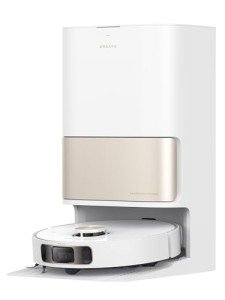Get Rid Of Robot Vacuum Cleaner: 10 Reasons Why You No Longer Need It

The Rise of Robot Vacuum Cleaners in Industrial Settings
In the last few years, the landscape of industrial cleaning has actually seen a significant change with the intro of robot vacuum. These automated devices are not just a novelty for homes; they have gained traction in storage facilities, manufacturing plants, and other industrial environments. This post checks out the performance, advantages, and considerations of robot vacuum within the industrial context, while responding to some regularly asked questions.
What are Robot Vacuum Cleaners?
Robot vacuum cleaners are automated cleaning devices equipped with advanced sensing units and innovation that enable them to browse around areas, find dirt, and vacuum surfaces without direct human intervention. In industrial settings, they are created to manage a range of particles types, facilitate regular cleaning schedules, and enhance total operational performance.
Table 1: Key Features of Industrial Robot Vacuum Cleaners
| Feature | Description |
|---|---|
| Navigation | Uses LiDAR or camera-based navigation for accurate mapping. |
| Size and Design | Compact and robust style to suit tight areas and endure hard environments. |
| Self-Charging | Automatically go back to its docking station for recharging. |
| Dustbin Capacity | Larger dustbin fit for industrial particles sizes and volumes. |
| Programs | Can be programmed for scheduling and specific cleaning jobs. |
| Information Collecting | Geared up with sensing units to gather data for maintenance and cleaning analysis. |
Advantages of Robot Vacuum Cleaners in Industrial Settings
The adoption of robot vacuum cleaners features a myriad of advantages:
Increased Efficiency:
- 24/7 Operation: Unlike human cleaners, robots can operate around the clock, contributing to continuous cleanliness without downtime.
- Time-Saving: Automated cleaning allows employees to focus on core jobs instead of cleaning responsibilities.
Expense Savings:
- Labor Costs: Maintaining a robot vacuum can minimize the need for a large cleaning personnel, decreasing total labor costs.
- Functional Efficiency: With improved cleanliness and reduced downtime due to maintenance problems, organizations can save money on operational expenses.
Improved Safety:
- Reduced Risk: By reducing the human involvement in hazardous cleaning environments, the risk of accidents is reduced.
- Consistent Cleaning: Robot vacuums make sure that locations are consistently cleaned up, decreasing slip hazards and unhealthy environments.
Increased Flexibility:
- Customizable Cleaning Routes: These makers can be set to tidy specific areas or floors, adapting to altering industrial layouts.
- Range of Surfaces: Industrial robot vacuums can manage numerous floor covering types, from concrete to tiles, making them flexible.
Ecological Impact:
- Sustainable Cleaning Solutions: Many models use minimal water and eco-friendly cleaning options, helping in corporate sustainability efforts.
Table 2: Industrial Applications of Robot Vacuum Cleaners
| Industry | Application |
|---|---|
| Manufacturing | Cleaning production lines and assembly locations. |
| Warehousing | Keeping tidy and orderly storage spaces. |
| Food Processing | Ensuring cleanliness in delicate areas to fulfill hygiene requirements. |
| Pharmaceuticals | Keeping ultra-clean environments for production. |
| Logistics and Distribution | Keeping paths clear for efficient operation. |
Difficulties and Considerations
While the advantages are significant, services should likewise consider several difficulties:
- Initial Investment: The in advance expenses of purchasing industrial robot vacuum cleaners can be considerable, though long-term cost savings may offset this expense.
- Maintenance and Repairs: Regular maintenance is vital to keep the robotic systems working optimally, and repairs can sustain additional costs.
- Combination: Businesses may require to incorporate these devices into existing workflows, which can require time and adjustment.
- Training and Support: Staff may require training to effectively manage these devices, especially when fixing or programs is needed.
FAQs About Robot Vacuum Cleaners in Industrial Settings
1. How much do industrial robot vacuum cost?
The cost can range from a few thousand to 10s of countless dollars, depending on requirements, features, and brand name.
2. What kinds of surface areas can they clean up?
Robot vacuum appropriate for different surfaces including carpets, tiles, concrete, and even some wood floorings.
3. How do they browse complicated industrial environments?
Most industrial robot vacuums use innovative navigation systems like LiDAR, cameras, and sensors to draw up and adapt to their surroundings for efficient cleaning.
4. Can they clean large areas without human intervention?
Yes, industrial robot vacuums are created to tidy extensive locations with preset paths and schedules, efficiently running autonomously.
5. Are these robots eco-friendly?
Numerous models focus on effectiveness and minimize water use, making them a more environmentally friendly cleaning option compared to conventional techniques.
The intro of robot vacuum cleaners into industrial environments signifies an exceptional development in cleaning technology. With their capability to enhance efficiency, lower labor expenses, and keep safety, these automated systems are paving the way for smarter and cleaner industrial operations. While best robot vacuum deals might exist, the long-lasting advantages and technological improvements are encouraging for industries seeking to enhance their cleaning protocols. As innovation continues to progress, we can anticipate further innovations in robot vacuum that will transform industrial cleaning practices much more.

